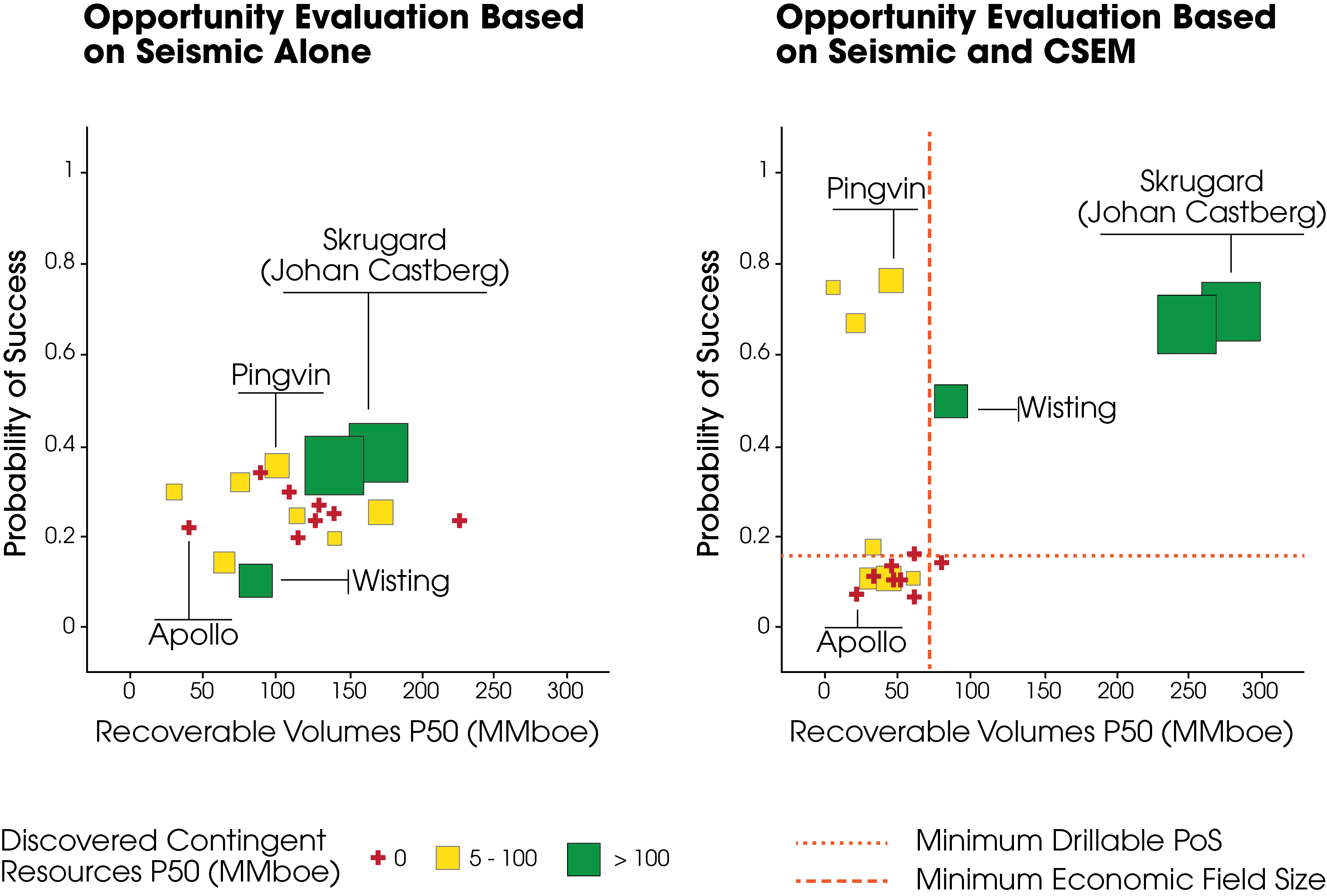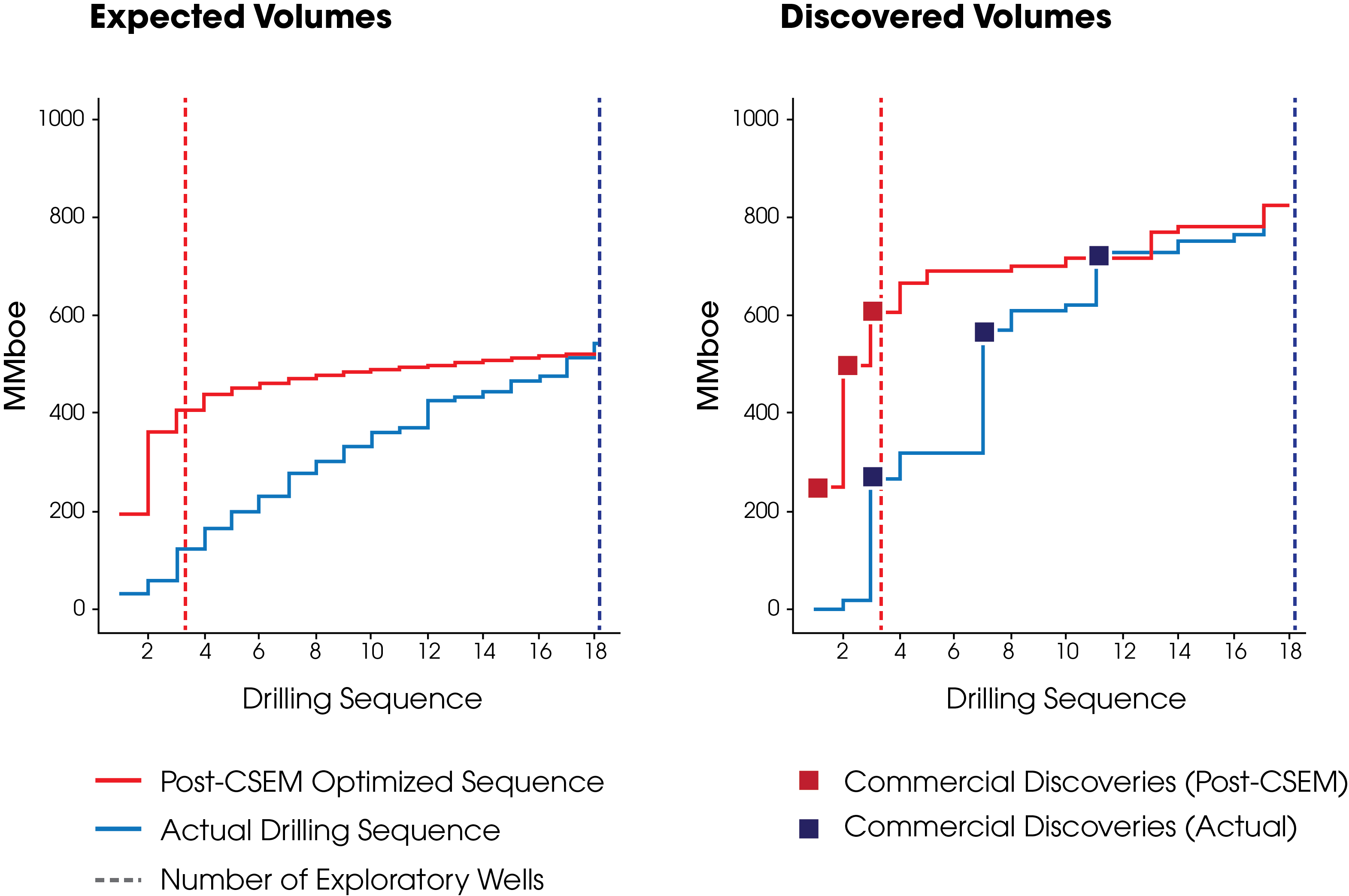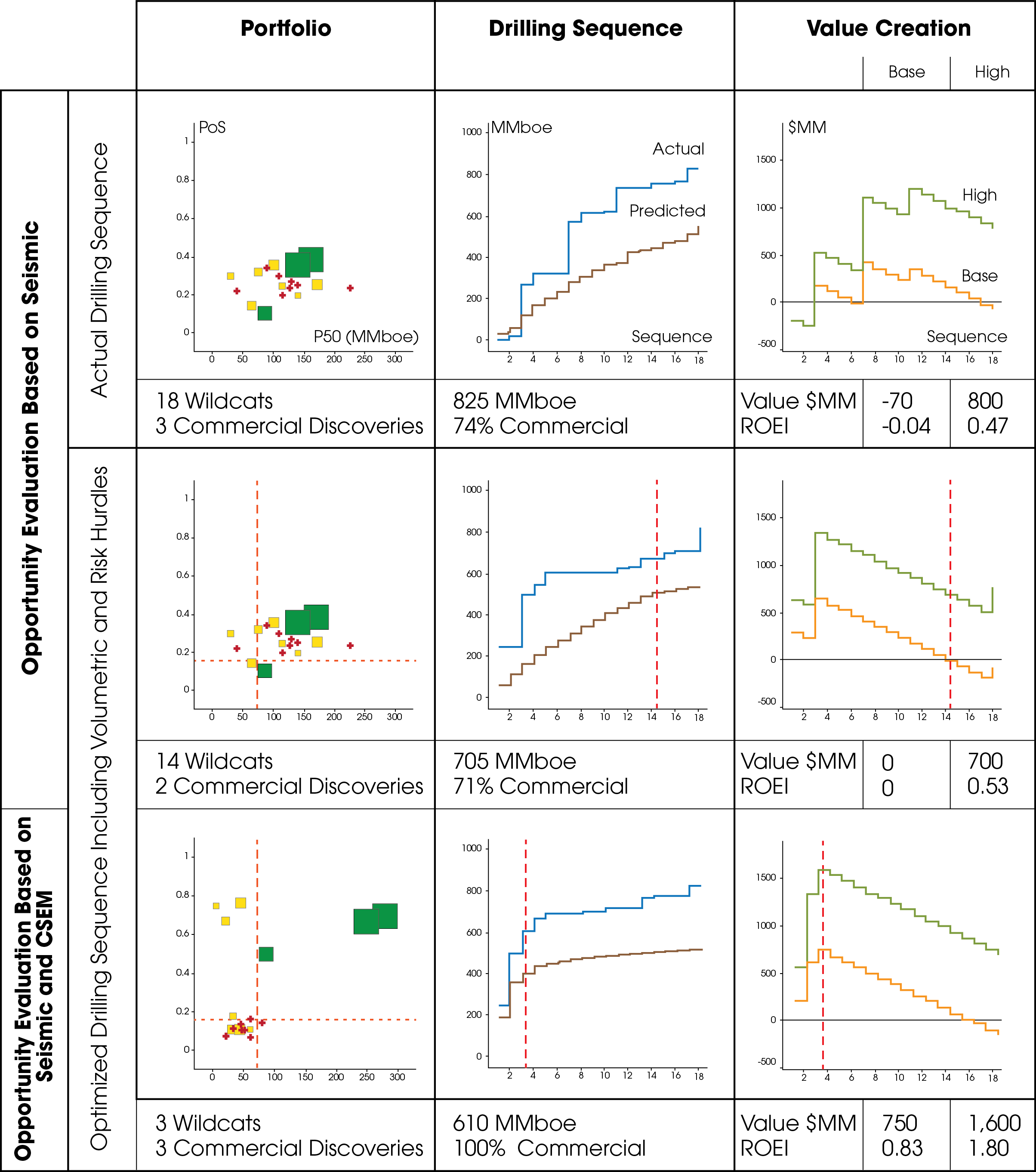The primary role of exploration organizations is to deliver commercial contingent resources that allow produced reserves to be replaced, that enable growth promises and that allow shareholder value to be met. The quality of exploration investment decisions is tightly linked to an understanding of the inherent uncertainty in the geological interpretation and associated volume and value evaluation.
During the exploration process, there are known uncertainties and unknown uncertainties. The known uncertainties are those that can be assessed, such as the probability of finding a certain volumetric range of hydrocarbons in a prospect, inferred primarily from seismic information. The unknown uncertainties represent opportunities (or risks) that have not yet been identified due to the absence of data, such as alternative play models. In this case the lack of evidence does not necessarily mean new opportunities don’t exist; they just cannot be seen yet.
Successful exploration companies must therefore carefully consider the type of information required in making their decisions and how the information will be utilized to minimize both types of uncertainty. The potential impact of new information has to be balanced against both its cost and the ease with which it can be embedded into existing decision-making.
CSEM technology
Seismic methods provide information about the acoustic impedance contrasts between geological layers, allowing structural definition of geological features and depositional systems analysis; lateral changes in acoustic impedance and amplitude-vs.-offset effects provide constraints on lithology and fluid presence. Yet interpreters are still left with large uncertainties in hydrocarbon presence and, if present, the volumes within undrilled prospects.
In contrast, controlled-source electromagnetic (CSEM) technology provides information on subsurface resistivity. In sedimentary basins, resistivity is primarily driven by the quantity of brine in the sediment. CSEM information also provides constraint on the area and anomalous transverse resistance (net thickness times resistivity contrast) of buried resistive layers.
CSEM-derived resistivity can therefore help explorers understand the fluid distribution and the size of the resistive bodies (net rock volume) in a basin—two of the largest uncertainties in the opportunity evaluation workflow.
Growing maturity
CSEM technology has undergone rapid evolution over the past 15 years. During this process, it has faced and is now overcoming adoption hurdles of a similar nature to those faced by geochemistry in the late ‘70s and seismic direct hydrocarbon indicators in the ‘90s.
While some acquisition systems reached maturity in the early 2000s, the algorithms to process the data into a broadly interpretable form naturally lagged behind. Even today, the core “processing” technology (3-D anisotropic inversion) is of a variable quality within the industry.
CSEM-derived resistivity images are not seismic volumes. They are sensitive to different earth properties with different levels of uncertainty. To the uninitiated, weaknesses in the information may be more obvious than strengths: Those fuzzy blobs will put off more than one geologist until they are taught how to interpret with, rather than against, the data uncertainties.
Like many new technologies, CSEM has been developed and promoted by domain experts with a limited understanding of end users and of how decisions are to be made with the information. This has led to a focus on data integration approaches suited to low-uncertainty environments. To the authors’ knowledge, any potential CSEM value propositions remain immature.
In the last few years, more experts of high-uncertainty-environment interpretation (explorers) have become engaged with the technology; corresponding progress in the reliable embedding of CSEM information in exploration is now working its way through to the literature.
Impact on exploration investment decisions
The authors had access to a CSEM dataset from the Norwegian sector of the Barents Sea that includes 18 wells drilled in the period from 1988 to 2015, with half drilled from 2013 to 2014 and only one drilled prior to 2007.
A reasonable quantitative prospect evaluation of the portfolio (Figure 1), based solely on geological and seismic information, leads to prospects ranging from 10% to 38% probability of success (PoS) with a P50 recoverable hydrocarbon range of 30 MMboe to 226 MMboe without any clear clustering.
 FIGURE 1. Eighteen Barents Sea prospect evaluations are compared to well outcomes. At left, reasonable PoS and P50 volume predictions made from publicly available seismic and geological information are shown. At right, updated predictions are demonstrated, with these predictions taking the seismically focused evaluation as a priori and updating with 3-D CSEM information. (Source: EMGS)
FIGURE 1. Eighteen Barents Sea prospect evaluations are compared to well outcomes. At left, reasonable PoS and P50 volume predictions made from publicly available seismic and geological information are shown. At right, updated predictions are demonstrated, with these predictions taking the seismically focused evaluation as a priori and updating with 3-D CSEM information. (Source: EMGS)
The same portfolio integrating CSEM information using the method outlined by Baltar and Barker, 2015, has a range from 6% to 77% probability of success and volumes between 5 MMboe and 280 MMboe. Most importantly, however, the portfolio now shows clear polarization and clustering.
Turning the clock back and redefining the drilling sequence based on this new CSEM-integrated interpretation (Figure 2) shows that, in this case, the first three wells to be drilled would be commercial discoveries and any subsequent wells (which should not be drilled based on risk and volumetric hurdles) would be dry or technical discoveries—the drilling of three instead of 18 wells with the same overall commercial success.
 FIGURE 2. The impact of CSEM on drilling sequence and number of exploratory wells is optimized based on decreasing expected hydrocarbon volumes (left). At right is the impact of an optimized drilling sequence on actual commercial discoveries with a success rate of three out of three for the post-CSEM sequence and a success rate of three out of 18 for the actual drilling sequence. (Source: EMGS)
FIGURE 2. The impact of CSEM on drilling sequence and number of exploratory wells is optimized based on decreasing expected hydrocarbon volumes (left). At right is the impact of an optimized drilling sequence on actual commercial discoveries with a success rate of three out of three for the post-CSEM sequence and a success rate of three out of 18 for the actual drilling sequence. (Source: EMGS)
One could argue that this comparison is unfair as the original sequence could never be optimized in this fashion due to license timing and well commitments. To address this, the return on exploration investment (ROEI, defined as the net present value divided by the exploration and appraisal investments) has been calculated for three alternative drilling sequences (actual, optimized without CSEM and optimized with CSEM). Using simple but valid cost and value assumptions based on the authors’ experience in the field, value creation (and erosion) curves were generated from these drilling sequences at two oil price scenarios ($60/bbl and $80/bbl). From these curves and the number of wildcats in each scenario, under a base price assumption, only the portfolio including CSEM and an optimized drilling sequence will have a positive return; all others will ultimately erode value (Figure 3).
 FIGURE 3. This figure summarizes the impact of CSEM-enabled investment decisions. The original drilling sequence of 18 exploratory wells delivered three commercial discoveries, with a negative ROEI based on $60 boe. A drilling sequence based on volumes and risks updated with CSEM information would have delivered three exploratory wells for three commercial discoveries for an ROEI of 0.83. (Source: EMGS)
FIGURE 3. This figure summarizes the impact of CSEM-enabled investment decisions. The original drilling sequence of 18 exploratory wells delivered three commercial discoveries, with a negative ROEI based on $60 boe. A drilling sequence based on volumes and risks updated with CSEM information would have delivered three exploratory wells for three commercial discoveries for an ROEI of 0.83. (Source: EMGS)
CSEM-derived resistivity applied in large surveys wherever uncertainty is large enough is a valuable tool that allows a significant reduction in both known uncertainties (volume ranges and chance of success) and unknown uncertainties (new lead generation and basin geology insight).
The biggest challenge now lies with oil companies that must adapt their exploration workflows and train their people to harness this potential.
References available.
Recommended Reading
Energy Spectrum, UGI JV Buys Three Appalachia Gathering Systems
2025-01-28 - Pine Run Gathering LLC, a joint venture between Energy Spectrum Partners and UGI Corp., purchased three gathering systems in Pennsylvania from Superior Midstream Appalachian LLC.
Shale Outlook Appalachia: Natural Gas Poised to Pay
2025-01-09 - Increasing gas demand is expected to rally prices and boost midstream planning as a new Trump administration pledges to loosen permitting—setting the stage for M&A in the Appalachian Basin.
Major Interest: Chevron, Shell Join Vaca Muerta Crude Pipe Project
2025-01-20 - Oil producers are pumping record levels from Argentina’s Vaca Muerta shale. Chevron and Shell have backed a new crude pipeline project that aims to boost takeaway capacity—and exports—of Vaca Muerta oil.
Shale Outlook Permian: The Once and Future King Keeps Delivering
2025-01-11 - The Permian Basin’s core is in full-scale manufacturing mode, with smaller intrepid operators pushing the basin’s boundaries further and deeper.
Gibson, Baytex Energy Enter Infrastructure Partnership in Duvernay
2025-03-12 - Baytex Energy, in partnership with Gibson Energy, is building midstream infrastructure in the Pembina Duvernay play that is expected to be completed by fourth-quarter 2025.
Comments
Add new comment
This conversation is moderated according to Hart Energy community rules. Please read the rules before joining the discussion. If you’re experiencing any technical problems, please contact our customer care team.





